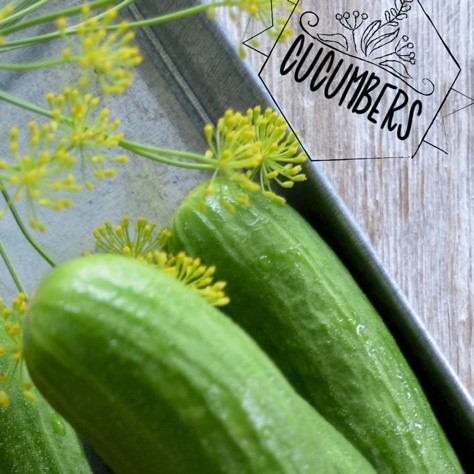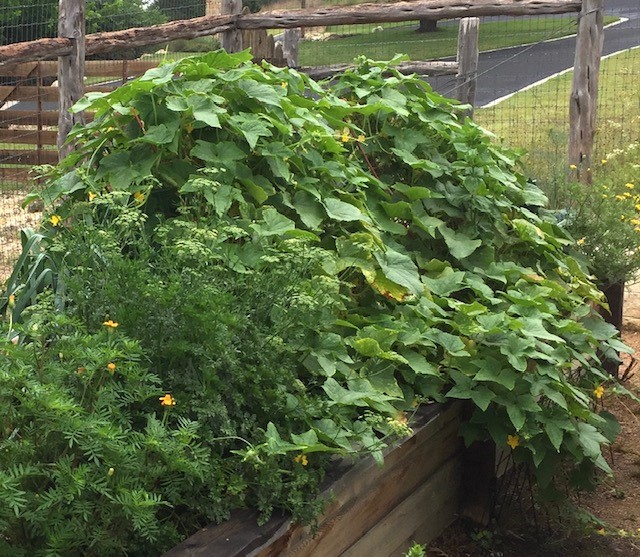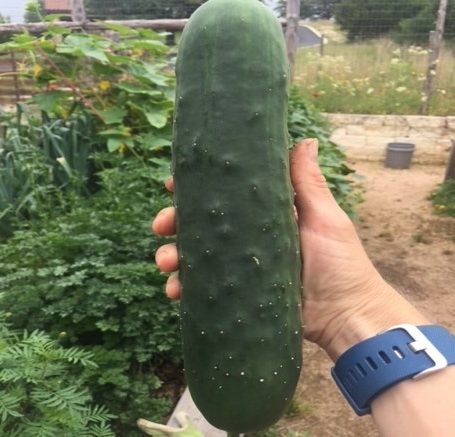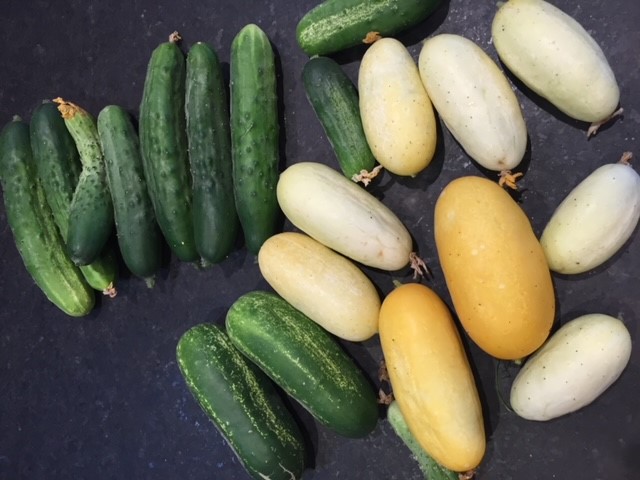By Michelle Hobbs, Bexar County Master Gardener

One of things I like most about gardening is sharing with friends and family. Last summer I gave a friend several cucumbers which she peeled, added a little salt, olive oil and balsamic vinegar served them to her husband who promptly announced, “I don’t know what type of cucumbers these are, but you need to get these every time you go to the grocery store!” My friend just laughed. Much like many vegetables, the taste of fresh picked cucumbers just can’t be duplicated by those commonly found in grocery stores. Fortunately, cucumbers are easy to grow if you meet their requirements. To maximize your chances for success, the following guidelines provide the basics:
Sun – Cucumbers must have full sun (8 hours or more each day) but can tolerate shade in the late afternoon.
Soil – Cucumbers can be grown in pots using a quality potting mix. The pot size matters, as cucumbers have extensive root systems. A 20-inch or larger pot that drains well is ideal for cucumbers. When grown in the ground the soil should be loose and heavily enhanced with organic matter (such as compost, well-rotted leaves, well composted manure, etc.) most of which can be commonly found at garden nurseries.
Fertilizer – Cucumbers are heavy feeders. They require fertilizer to get the best production. A slow-release fertilizer at the start of the growing season and a liquid fertilizer every week or 2 will maximize your production.
Water – Much like most fruiting vegetables, cucumbers require a fair amount of water. Be careful with overhead watering, as cucumbers are susceptible to fungal diseases (like powdery mildew) if their leaves get wet. Consider a drip system or water underneath the foliage to the extent possible.
Timing – Cucumbers are warm-season vegetables that can be direct seeded in the spring and fall. The optimal soil temperature for cucumber seeds to germinate is 85 degrees but you will still have success if planted in soil that is 75-95 degrees. Just plant a few extra seeds to maximize your chances for success. If you want a jump on the season, you can start your seeds indoors earlier or purchase transplants to use as soon as the soil warms up.
Pollination – Cucumbers require bees for pollination. A common issue for cucumbers grown in pots is a lack of pollination. This will produce few and distorted looking cucumbers. It is critical that you have adequate bees. Try to put your cucumbers by flowering plants such as basil or salvia. Really any plants where you usually see a lot of bees will be great.
Pests – There are a number of pests that attack cucumbers, but the most notorious ones are cucumber beetles, aphids and squash bugs. It is important to stay on top of any outbreaks and control them quickly with the appropriate pesticide.

Trellising – While cucumbers can be allowed to grow along the surface of the ground, providing a trellis they can grow up will greatly decrease the cucumber’s problems with fungal diseases and insects. You will also maximize the space in a small garden when you allow them to grow up, rather than out. Their tendrils easily attach to fences, tomato cages and even neighboring plants if planted too close! The ideal spacing is 1-2 cucumber plants spaced 3 feet apart or 2 plants in a 20-inch pot.

Harvesting – Be sure to check on your cucumbers daily once they start growing as they grow very quickly and can sometimes hide in the foliage. Cucumbers always taste better when harvested on the smaller size for that particular variety. You want to avoid harvesting cucumbers after a heavy rain as the taste will be diluted.

One of the things I also like about cucumbers is that, in addition to buying transplants from garden nurseries in the spring (and sometimes fall), there are a huge number of varieties available if you start cucumbers from seeds. I find it fun to experiment with new varieties each year. Some are more successful than others. A couple of years ago, I grew a variety called Poona Kheerathat looked like a russet potato. It wasn’t my favorite from a taste perspective, but it was fun to surprise people with it. Some of my favorites that I grow each year are two heirloom types (Lemon and Boothby’s Blonde). Last year a grew Chelsea Prize, a variety of English Cucumber that had a surprisingly large vine but was very prolific and tasty. I also grow the more reliable and disease resistance varieties that seem to like our hot climate such as Sweet Success. If you only have space for one type of cucumber and like to pickle, consider growing pickling cucumbers as they can also be eaten on salads.
If you would like to learn more about growing cucumbers, Texas A&M AgriLife has a number of great resources. These resources can be found on the Bexar County Master Gardener website (bexarmg.org) on the Vegetable Gardening or Gardening Library pages in addition to the Aggie Horticulture website.
For more information:
Spring Vegetable Varieties – AgriLife Extension – Bexar County. Planting varieties and planting times for the San Antonio area.
Cucurbit Problem Solver – Aggie Horticulture website. A Guide to the Identification of Common Problems of melons, pumpkins, squash, cucumbers, etc.
EZ Gardening – Cucumbers – AgriLife Extension publication.
